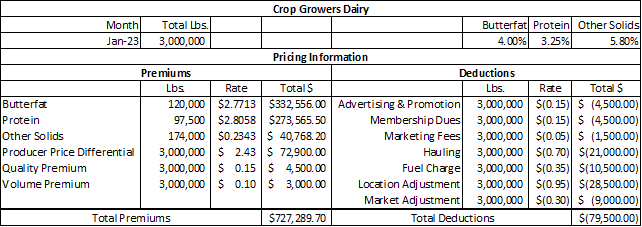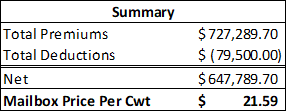March 7, 2023

Understanding your milk check is a crucial piece to your operation’s revenue and risk management strategy. Milk checks vary between cooperatives and who you sell your milk to, but breaking it down by how the line items on your check are calculated can help you determine your mailbox price and what you are paid.
Milk Price Basics
Pounds
Your milk check includes how many pounds you produced in the month, as well as pounds for three component factors: butterfat, protein, and other solids. Many Northeast dairy producers are paid based on pounds of milk components.
Pricing
The majority of Northeast producers are also located in Federal Milk Marketing Order (FMMO) One which is one of the eleven Federal Milk Marketing Orders in the United States. FMMO sets minimum prices that dairy producers must be paid. The prices on your check should match the prices listed on the monthly Pool Price Announcement. The component values are determined from product price formulas which are based on the USDA National Dairy Products prices. Each of the component factors are multiplied by the component prices per pound to get a piece of your milk check revenue.
Producer Price Differential
The Producer Price Differential (PPD) is basically the amount of the minimum milk price that is not captured in the Class III component values. It represents the difference between the other milk classes and the Class III component level while also factoring in other adjustments, both positive and negative, as specified in marketing order regulations. The PPD calculations and the component prices can be found on the FMMO website.
Deductions and Other Fees
Many producers’ checks also include premiums, marketing fees and hauling deductions. Producers who belong to a cooperative also typically have deductions for membership dues and possibly even balancing fees. Premiums may include an incentive for producing high quality milk or a certain volume metric.
Seasonality of milk supply and demand play a part in your milk check as well. If you are charged a balancing fee, your deduction is likely higher during the spring and early summer when there is abundant milk in the marketplace due to weakened demand and a seasonal increase in milk production. These balancing deductions may be less in the fall when demand picks up due to schools opening, and milk production tends to decrease.
Mailbox Price
To get your overall pay price (or mailbox price), add your total premium and component dollars together and take out all deductions.
Using the example below: $727,289.70 (total premium and component dollars) - $79,500.00 (all deductions) = $647,789.70 (Net)
To get your price per hundredweight (cwt.), divide the total dollars (with deductions) by the total pounds produced for the month, then multiply that value by 100.
Using the example below: [ $647,789.70 (Net) / 3,000,000 (total lbs) ] x 100 =$21.59 (cwt)
Milk Price Volatility
It’s no surprise that milk prices vary and your mailbox price changes each month. Producers can’t change the prices set by the marketing order, but there are three pieces to the milk check puzzle that you can manage: milk quality, components and guaranteeing yourself a certain price with a risk management plan.
Still have questions about your milk check, or if you're interested in developing a risk management plan to manage price volatility, please contact your local Crop Growers agent.







